
On a plate hanging on the entrance of a museum, located at the foot of the Ankara Castle in the Turkish capital Ankara, there is the seal of Hittite King IV Tuthalia (1250-1220 B.C). Along with it, “Anatolian Civilizations Museum 1921” is written.
But behind that plate is hidden an extraordinary history of civilization.
In 1921, thee Greek army was 70-80 kilometers from the Turkish Parliament, which was only formed a year before.
The enemy’s strength on the one hand, and poverty on the other, Mustafa Kemal Atatürk, the head of the Turkish Parliament, ordered the establishment of a Cultural Directorate, which was established with four officials. They started collecting the capital’s historical, cultural and religious heritage regardless of whether they were Muslim or non-Muslim.
After the formation of the Turkish Republic, Atatürk once again emphasized the importance he attaches to Turkish culture, saying, “Culture is the foundation of the Republic of Turkey,” and considered museums as places where the assets of Turkish culture are preserved and exhibited.
In 1921, the first cultural director, Mübarek Galip Bey, started forming a museum by collecting artworks from the temple of Augustus and the Roman Bath.
After the foundation of the Republic of Turkey, historical artifacts began to come from various regions of Anatolia, and the establishment of the Hittite Museum was decided at the first stage.
The next cultural director, Hamit Zübeyr Koşay, proposed to then Education Minister Saffet Arıkan to restore the ruined Mahmut Paşa Bedesten and Kurşunlu Inn and to turn these places into a museum.
Then these two places were restored and the Museum of Anatolian Civilizations was established as one of the world’s respected museums.
The Hittite works came to the museum from the first Turkish archeological excavation that started in the Central Anatolian province of Çorum’s Alacahöyük, as well as from various regions of Anatolia.
The restoration of the museum continued until 1968 because of the economic problems caused by the World War and negligence of some state officials.
In the meantime, with the completion of the middle area of the museum in 1940, the delegation headed by the German archaeologist H. G. Guterbock started to place the artifacts in the museum.
The museum was opened to visitors in 1943 and the museum structure took its final form in 1968.
Kurşunlu Inn serves as research, library, conference hall and laboratory, and Mahmut Pasha Bedesten serves as an exhibition area.
In the Ankara section on the lower floor, elephant, rhinoceros, giant tortoise, and 10 million-year-old giraffe bones, which lived in Ankara 15 million years ago, are on display.
Then the name of the museum was changed from Hittite Museum to the Museum of Anatolian Civilizations because the museum covered all Anatolian civilizations. On April 19, 1997 in Lausanne, Switzerland, it ranked first among 68 museums, and got the title “Museum of the Year in Europe.”
It is known that there are approximately 180,000 historical pieces in the warehouse of the museum, most of which are unimportant finds, and they are waiting for scientific research. Only 7,000-8,000 pieces can be exhibited currently in the museum.